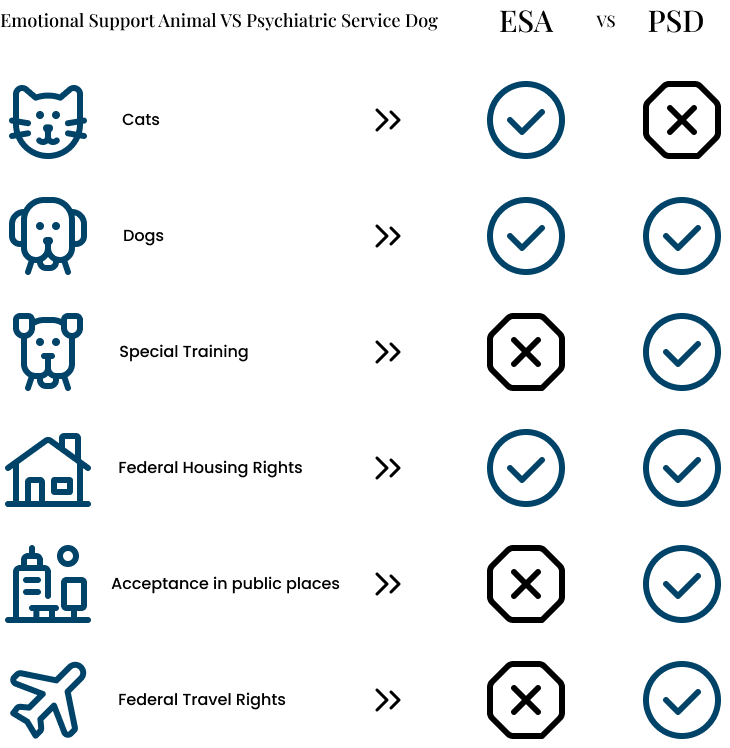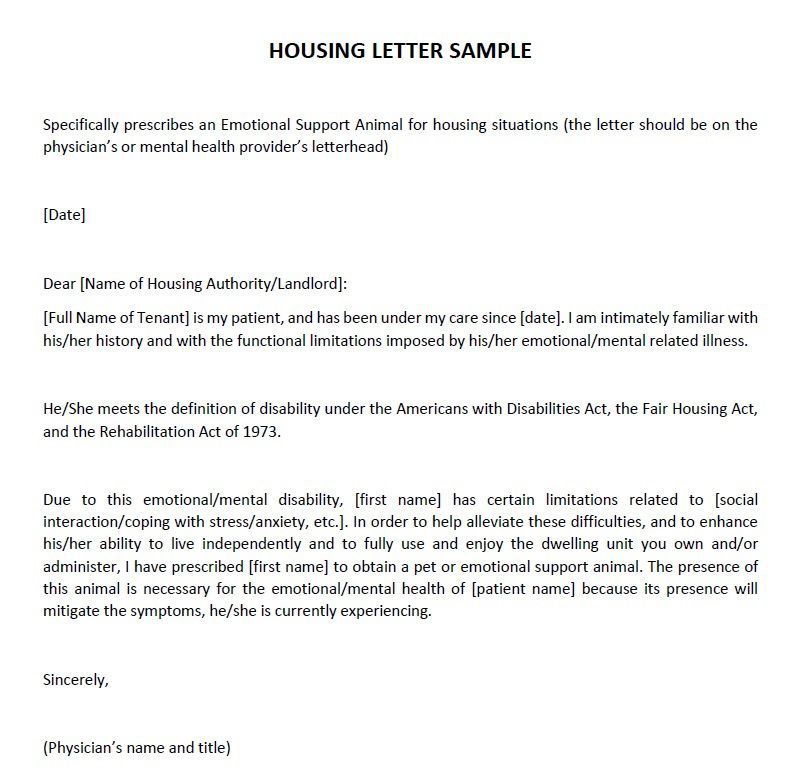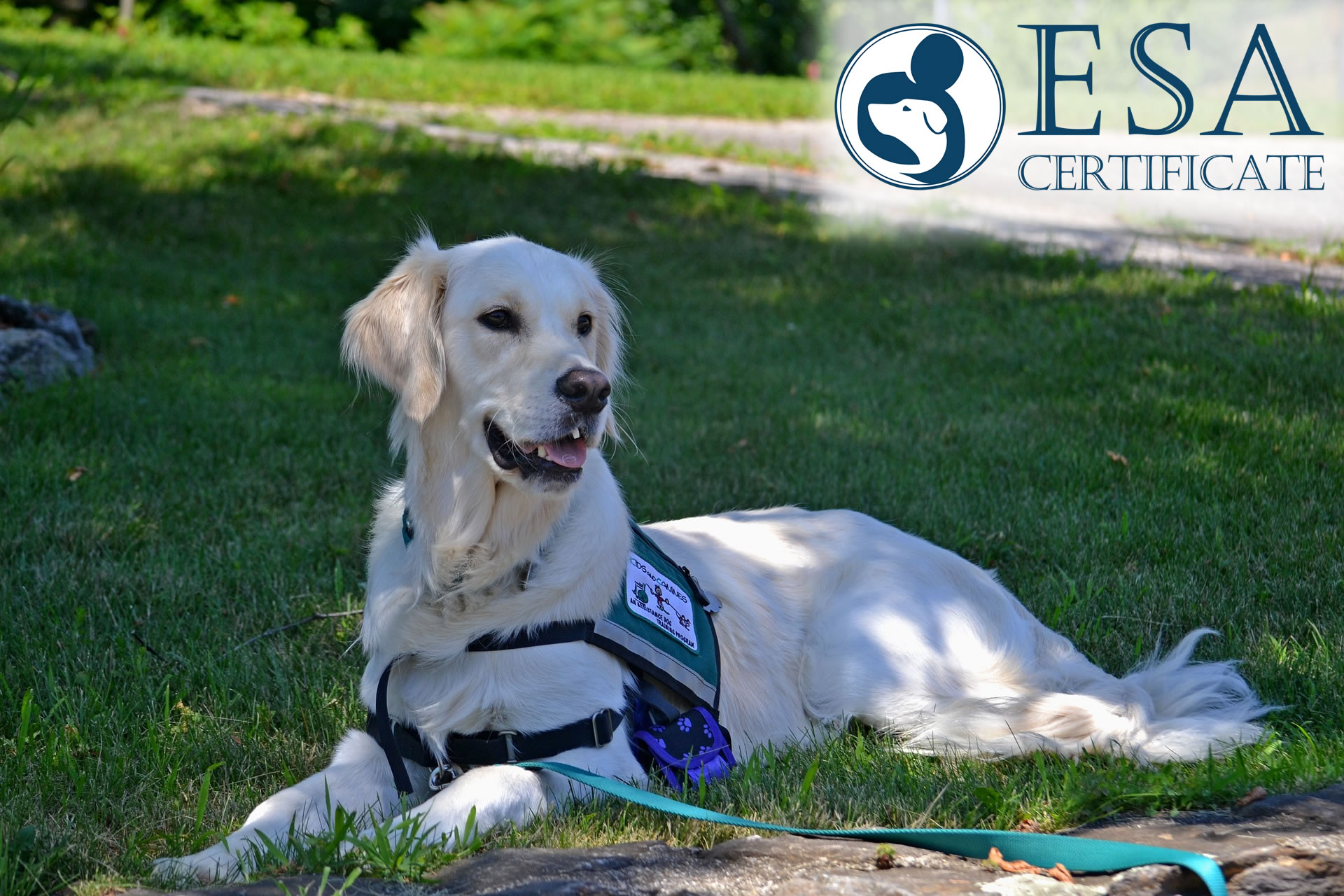When it comes to assistance animals, emotional support animals (ESAs) are often misconceived as Psychiatric Service Dogs (PSDs). ESAs and PSDs are mostly used for common purposes, which is to help their owners overcome their mental and emotional issues. Those are the only similarities between them, and there are a few crucial differences between them, out of which, one of the major differences is regarding their legal rights.
In today’s article, we will be discussing these key differences and answer one of the most important doubts that arise in the minds of most ESA owners. The doubt is about whether or not they would be able to turn their ESA into a psychiatric service dog. So, is it possible for turning an ESA into a psychiatric service dog? The answer to that question is ‘Maybe’. There won’t be a requirement of a PSD to all ESA owners and not all ESAs could be turned into PSDs. Let us have a look at some of the legal factors that are responsible for this.
1. What are the important legal rights that vary between emotional support animals and psychiatric service dogs?
Emotional support animals and psychiatric service dogs have different privileges, while they are being regulated by a different set of rules. Psychiatric service dogs have more access in public places according to the Americans with Disabilities Act (ADA), when compared to ESAs. To be precise, PSDs are allowed almost anywhere their owner is allowed. This means a PSD can go along with its owner in almost any place, including stores, libraries, stadiums, hotels, beaches that have a ban on dogs, etc. However, people having ESAs might not be allowed in most places where PSDs are allowed.
When it comes to housing, both PSDs and ESAs have the same rights under the Fair Housing Act (FHA) that allow them to accommodate their owners in various types of housing (including the ones that won’t allow pets).
PSDs have special privileges while traveling on planes. On the other hand, there have been some changes made by the US Department of Transportation (DOT), which limited its rules concerning emotional support animals on planes. Since January 11, 2021, it is not mandatory for airlines to accommodate emotional support animals. However, some airlines still allow ESA owners to travel along with their animal companions. PSDs could still accompany their owners without having any additional fees, regardless of the new changes made by DOT.
2. What’s the main difference between an ESA and a PSD?

Emotional support animals, as well as psychiatric service dogs, assist in providing support and comfort to those people who are suffering from depression, anxiety, PTSD (Post Traumatic Stress Disorder), phobias, etc. Not only that but they are also proven to be helpful for people suffering from autism and disabilities related to learning. The only major difference between ESAs and PSDs is how they actually provide support to their owners.
A PSD should be trained so that it can be able to perform certain types of tasks that helpful for its owner’s disabilities. On the contrary, ESAs won’t be needing any sort of special training. ESAs are known to provide support and comfort with nothing but just their existence. Various types of animals could be kept as ESAs, which include dogs, cats, rabbits, fish, hamsters, iguanas, and many more.
However, only dogs could be kept as psychiatric service animals, which should be trained as well. A PSD would be generally required to help with tasks that are related to assisting their owners with their disabilities. PSDs are kept for performing a wide variety of tasks, which are as follows.
- Helping their owners in remembering to take their medication on time.
- Deviating owners while they are dealing with issues such as crying, flashbacks, nightmares, etc.
- Stopping owners from getting involved in harmful activities such as scratching, self-harm, etc.
- Helping their owners become calm while they are dealing with pressure and tactile stimulation.
- Supporting and positioning the owners during times of panic attacks.
- Helping the owner in avoiding or dealing with psychotic episodes.
- Putting some pressure with their teeth or nuzzling for stopping psychiatric issues.
- Disrupting repetitive behaviors.
- Assisting the owner in maintaining a steady routine.
- Preventing the owner from having hypersomnia (excess amount of sleep).
In order to be more specific on understanding the difference between an ESA and PSD, an example has been provided by the ADA, which is as follows.
Example – If a dog is trained for sensing an anxiety attack that is about to occur, and the dog takes the necessary action in avoiding that attack or helps in mitigating the symptoms, then it would be a psychiatric service dog. Whereas, if a dog provides comfort to a person with nothing more than its presence, then it would not be considered as a service dog (as per the ADA) and is called an emotional support animal.
3. The process of qualifying for an ESA and a psychiatric service dog?
Similar to emotional support animals, psychiatric service dogs are used for assisting people dealing with psychiatric disabilities. A ‘disability’ or ‘disorder’, in terms of assistance animal laws, means the person is suffering from mental issues, which can either be temporary or permanent and limit a person’s abilities or his/her activities. Mental issues include the aspects that are related to mental or emotional illnesses along with learning disabilities.
For being able to qualify for a psychiatric service dog, a person must be suffering from a mental illness or a learning disability that has limitations on their most important life activities such as working, sleeping, learning, and others. The process of qualifying for an emotional support animal is also much similar to this. Both PSD and ESA owners are known to rely on their assistance animals for dealing with conditions like depression, anxiety, PTSD, autism, phobias, and other disabilities.
If you believe that you are eligible for getting qualified, a licensed healthcare professional is the most efficient choice to confirm. A licensed therapist would be able to determine whether you need an assistance animal to deal with your symptoms and evaluate whether you are dealing with psychiatric disabilities or not. A therapist can describe the severity of your situation, whether is mental or emotional and to what extent does it impact your every day (major) life activities. Such types of professionals could also suggest to you some ways of dealing with your issues, which might also include the use of an assistance animal. While you are dealing with problems either mentally or emotionally, it is very important for you to seek the help of a professional.
4. Is it possible for an ESA to become a psychiatric service dog?
If you already own a dog, which is an ESA, it is possible to train your ESA so that it can become a psychiatric service dog upon meeting with some specific terms and conditions.
If your disability doesn’t need your dog to do any task in providing the support you require, then you would be just needing an emotional support animal and not a PSD.
On the other hand, if you need your assistance dog to help with some of the tasks that are related to your disability (like what we discussed earlier), then you are in the need of a PSD and your ESA can qualify to become a PSD.
It should be taken into consideration that psychiatric service dogs should acquire complete training before it can be considered as a PSD. A service dog that is currently undergoing the process of training might not be considered as a PSD and won’t be able to enjoy all the legal privileges and benefits.
Psychiatric service should also be trained on how they behave in public. In contrast to emotional support animals, PSDs are allowed to accompany their owners anywhere in public places. A psychiatric service dog is required to perform all the necessary tasks in every place the owner goes, which included crowded places or busy environments that are usually full of distractions.
A PSD that does not behave well in public by doing activities such as running around without control, unnecessarily barking or growling, jumping on other people and any other similar activities might be asked to leave the place. Based on the travel rules of DOT, a psychiatric service dog that exhibits symptoms such as those mentioned above might be considered as service dogs that aren’t properly trained and would be asked to exit the plane or leave the airport. When an assistance animal is not able to be concentrated and composed on the tasks assigned to it, especially in places with other people or animals, it is not eligible to become an ideal psychiatric service dog.
5. How to obtain a letter for a psychiatric service dog?
To get qualified for a psychiatric dog, a person must be suffering from a disability that is qualified as a psychiatric disability, and your dog should be trained so that it can help that specific person with that particular disability. If you need additional documentation, or if you aren’t sure about your disability (whether it qualifies as a PSD), you could contact your doctor or therapist for a psychiatric service dog letter (known as a PSD letter). If your current doctor or therapist isn’t able to help you with your requirement, you can apply for a PSD letter online.
A Brief step-by-step process:
- State your requirement for a PSD
- Consult your doctor/therapist
- If you aren’t able to acquire it from your doctor, opt for an online service that allows you to connect with a doctor or therapist.
A PSD letter is a letter that has been provided by a doctor, therapist, or any other licensed healthcare professional, which states that you qualify for an assistance animal. Obtaining a PSD provides you with legal rights in housing, flights, and many other public areas. A PSD letter consists of the information from your doctor/therapist and states the information regarding your disability and why you qualify for a PSD. In order to begin the process of qualifying for a PSD letter, complete the PSD questionnaire.
6. Is it possible to train an ESA to make it into a PSD?
If you are suffering from a psychiatric disability that needs you to have an assistance animal that can perform specific tasks related to assisting that disability, you can train an already existing ESA and turn it into a PSD. There is no professional training or specific certificate required to turn your ESA into a psychiatric service dog. Even though there are many organizations and professional trainers that assist in the training process, both ADA and DOT allow owners to carry out the training process by themselves.
There is no recognized way of certifying the process of the completion of the training for a PSD, yet there are some organizations that spread unofficial regulations and standards.
7. How can somebody verify the difference between PSD and ESA?
How somebody else is able to verify whether you have a PSD or ESA will rely on some specific conditions. For example, if you have a PSD and walk into a public place, let’s say a grocery store, the staff members can ask two types of questions, which are as follows.
- Is the psychiatric service dog required to assist with a disability?
- What is the specific task that has been assigned to that PSD?
The staff members won’t be allowed to demand the particular documents, or they cannot ask you to show a demonstration of the dog performing its tasks or ask particular questions regarding the owner’s disabilities.
There is no particular need for psychiatric service dogs to wear vests, tags, harnesses, etc., and the owners aren’t required to carry the certifications or ID cards wherever they go. However, most of the people who own PSDs carry these things voluntarily so that they can prove that they are eligible to have a PSD (if such a case was ever to happen). In general, PSD owners are conscious of their disabilities and use a PSD letter or any gear related to their service dog (such as a harness) to avoid unnecessary questions. The DOT also stated that airlines can assume that a dog is a PSD when they see things such as harnesses, vests, or tags.
When you are traveling on a plane, along with your PSD (from January 11, 2021), airlines can ask you for submitting a form that has been created by the DOT before your travel. This form requires PSD owners to fill in the following information.
- The PSD has received training so that it can perform tasks for the owner.
- The PSD should also have received training related to its behavior in public.
- The PSD will be under the control of its owner all the time.
- In case of misbehavior, the airlines can choose not to provide the privileges and rights offered to PSDs.
- The PSD owner is responsible for any sort of damage that has been caused by the PSD.
A PSD owner should also ensure that the PSD has received all the necessary vaccination. This form, provided by DOT, is a self-certifying form. This means the owner must sign the document and make all the necessary certifications by themselves. If there is any false information present in the form, the person would be charged with fines and other penalties according to federal law. Given below is a sample of the DOT Service Animal Transportation form.

In the case of emotional support animals, a recommendation letter (known as an ESA letter) acquired from a licensed healthcare professional would be needed. Landlords could ask the tenant to submit a letter that has been signed by a licensed therapist before allowing them to accommodate an ESA. Before DOT’s latest rules, ESAs were accepted on flights if the passenger was able to present an ESA letter. But, after the new rules made by DOT came into existence (January 11, 2021), there is no mandatory requirement for the airlines to allow ESAs. There are some airlines that still continue to accept ESAs on the flight without imposing any additional charges.
8. Final Thoughts:
If you want to train your emotional support animal and turn it into a psychiatric service dog, there are some aspects that are to be taken into consideration. ESAs and PSDs are required by the people who, in most cases, have the same types of issues, yet most of them have issues that don’t require a dog to be trained and assist them with those disabilities.
Nonetheless, if you own an ESA and have a mental or emotional issue that needs assistance from a trained service dog, then your ESA can be trained to be turned into a PSD. If you already have an ESA that performs certain types of tasks to assist you with your issues or disabilities, you can get qualified for an ESA letter by completing this questionnaire.
You should always remember that a PSD has to be dully trained, and the task in which they specialize should assist in helping the owner to overcome their disabilities. Additionally, if there is a PSD being taken into public places or planes, it must be trained to deal with situations of intense pressure. The PSDs should cope with other people, children, and other animals. You should note that all the breeds won’t have this type of temperament or the necessary personality traits to do so.
Training an ESA to turn it into a PSD is not considered an easy process, yet you can do it on your own or by taking the help of a professional trainer or organization specializing in those services. If you think that you qualify for a PSD and you are not sure, the best way of proceeding with the process of discussing your needs is by getting in touch with a licensed mental health professional.


